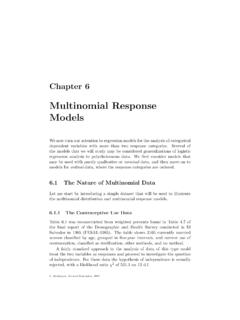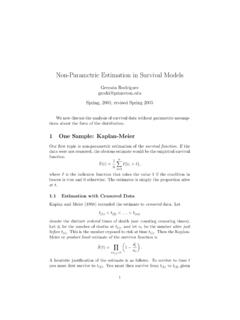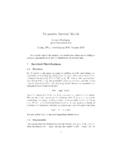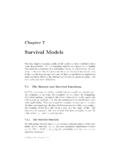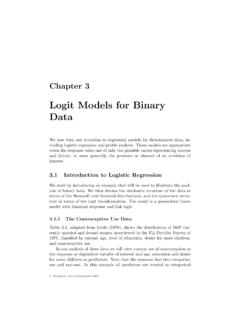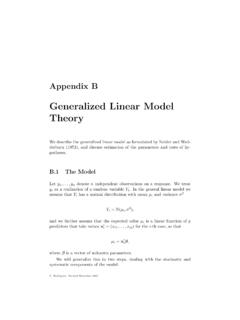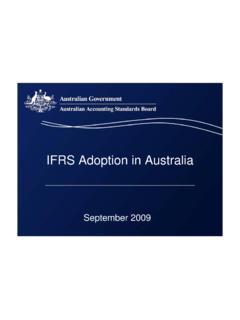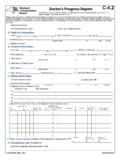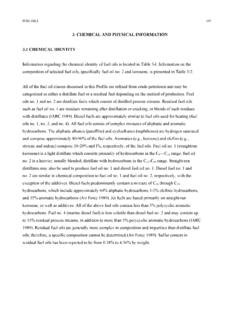Transcription of Logit Models for Binary Data
1 Chapter 3. Logit Models for Binary data We now turn our attention to regression Models for dichotomous data , in- cluding logistic regression and probit analysis. These Models are appropriate when the response takes one of only two possible values representing success and failure, or more generally the presence or absence of an attribute of interest. Introduction to Logistic Regression We start by introducing an example that will be used to illustrate the anal- ysis of Binary data . We then discuss the stochastic structure of the data in terms of the Bernoulli and binomial distributions, and the systematic struc- ture in terms of the Logit transformation. The result is a generalized linear model with binomial response and link Logit . The Contraceptive Use data Table , adapted from Little (1978), shows the distribution of 1607 cur- rently married and fecund women interviewed in the Fiji Fertility Survey of 1975, classified by current age, level of education, desire for more children, and contraceptive use.
2 In our analysis of these data we will view current use of contraception as the response or dependent variable of interest and age, education and desire for more children as predictors. Note that the response has two categories: use and non-use. In this example all predictors are treated as categorical G. Rodr guez. Revised September 2007. 2 CHAPTER 3. Logit Models FOR Binary data . Table : Current Use of Contraception Among Married Women by Age, Education and Desire for More Children Fiji Fertility Survey, 1975. Desires More Contraceptive Use Age Education Total Children? No Yes <25 Lower Yes 53 6 59. No 10 4 14. Upper Yes 212 52 264. No 50 10 60. 25 29 Lower Yes 60 14 74. No 19 10 29. Upper Yes 155 54 209. No 65 27 92. 30 39 Lower Yes 112 33 145. No 77 80 157. Upper Yes 118 46 164. No 68 78 146. 40 49 Lower Yes 35 6 41. No 46 48 94.
3 Upper Yes 8 8 16. No 12 31 43. Total 1100 507 1607. variables, but the techniques to be studied can be applied more generally to both discrete factors and continuous variates. The original dataset includes the date of birth of the respondent and the date of interview in month/year form, so it is possible to calculate age in single years, but we will use ten-year age groups for convenience. Similarly, the survey included information on the highest level of education attained and the number of years completed at that level, so one could calculate completed years of education, but we will work here with a simple distinction between lower primary or less and upper primary or more. Finally, desire for more children is measured as a simple dichotomy coded yes or no, and therefore is naturally a categorical variate. The fact that we treat all predictors as discrete factors allows us to sum- marize the data in terms of the numbers using and not using contraception in each of sixteen different groups defined by combinations of values of the pre- INTRODUCTION TO LOGISTIC REGRESSION 3.
4 Dictors. For Models involving discrete factors we can obtain exactly the same results working with grouped data or with individual data , but grouping is convenient because it leads to smaller datasets. If we were to incorporate continuous predictors into the model we would need to work with the orig- inal 1607 observations. Alternatively, it might be possible to group cases with identical covariate patterns, but the resulting dataset may not be much smaller than the original one. The basic aim of our analysis will be to describe the way in which con- traceptive use varies by age, education and desire for more children. An example of the type of research question that we will consider is the extent to which the association between education and contraceptive use is affected by the fact that women with upper primary or higher education are younger and tend to prefer smaller families than women with lower primary education or less.
5 The Binomial Distribution We consider first the case where the response yi is Binary , assuming only two values that for convenience we code as one or zero. For example, we could define (. 1 if the i-th woman is using contraception yi =. 0 otherwise. We view yi as a realization of a random variable Yi that can take the values one and zero with probabilities i and 1 i , respectively. The distribution of Yi is called a Bernoulli distribution with parameter i , and can be written in compact form as Pr{Yi = yi } = iyi (1 i )1 yi , ( ). for yi = 0, 1. Note that if yi = 1 we obtain i , and if yi = 0 we obtain 1 i . It is fairly easy to verify by direct calculation that the expected value and variance of Yi are E(Yi ) = i = i , and ( ). var(Yi ) = i2 = i (1 i ). Note that the mean and variance depend on the underlying probability i.)
6 Any factor that affects the probability will alter not just the mean but also the variance of the observations. This suggest that a linear model that allows 4 CHAPTER 3. Logit Models FOR Binary data . the predictors to affect the mean but assumes that the variance is constant will not be adequate for the analysis of Binary data . Suppose now that the units under study can be classified according to the factors of interest into k groups in such a way that all individuals in a group have identical values of all covariates. In our example, women may be classified into 16 different groups in terms of their age, education and desire for more children. Let ni denote the number of observations in group i, and let yi denote the number of units who have the attribute of interest in group i. For example, let yi = number of women using contraception in group i.
7 We view yi as a realization of a random variable Yi that takes the values 0, 1, .. , ni . If the ni observations in each group are independent, and they all have the same probability i of having the attribute of interest, then the distribution of Yi is binomial with parameters i and ni , which we write Yi B(ni , i ). The probability distribution function of Yi is given by ! ni Pr{Yi = yi } = iyi (1 i )ni yi ( ). yi for yi = 0, 1, .. , ni . Here iyi (1 i )ni yi is the probability of obtaining yi successes and ni yi failures in some specific order, and the combinatorial coefficient is the number of ways of obtaining yi successes in ni trials. The mean and variance of Yi can be shown to be E(Yi ) = i = ni i , and ( ). var(Yi ) = i2 = ni i (1 i ). The easiest way to obtain this result is as follows. Let Yij be an indicator variable that takes the values one or zero if the j-th unit in group i is a success or a failure, respectively.
8 Note that Yij is a Bernoulli random variable with mean and variance as given in Equation We can write the number of successes Yi in group i as a sum of the individual indicator variables, so P. Yi = j Yij . The mean of Yi is then the sum of the individual means, and by independence, its variance is the sum of the individual variances, leading to the result in Equation Note again that the mean and variance depend INTRODUCTION TO LOGISTIC REGRESSION 5. on the underlying probability i . Any factor that affects this probability will affect both the mean and the variance of the observations. From a mathematical point of view the grouped data formulation given here is the most general one; it includes individual data as the special case where we have n groups of size one, so k = n and ni = 1 for all i. It also includes as a special case the other extreme where the underlying probability is the same for all individuals and we have a single group, with k = 1 and n1 = n.
9 Thus, all we need to consider in terms of estimation and testing is the binomial distribution. From a practical point of view it is important to note that if the pre- dictors are discrete factors and the outcomes are independent, we can use the Bernoulli distribution for the individual zero-one data or the binomial distribution for grouped data consisting of counts of successes in each group. The two approaches are equivalent, in the sense that they lead to exactly the same likelihood function and therefore the same estimates and standard errors. Working with grouped data when it is possible has the additional advantage that, depending on the size of the groups, it becomes possible to test the goodness of fit of the model . In terms of our example we can work with 16 groups of women (or fewer when we ignore some of the predictors).
10 And obtain exactly the same estimates as we would if we worked with the 1607 individuals. In Appendix B we show that the binomial distribution belongs to Nelder and Wedderburn's (1972) exponential family, so it fits in our general theo- retical framework. The Logit Transformation The next step in defining a model for our data concerns the systematic structure. We would like to have the probabilities i depend on a vector of observed covariates xi . The simplest idea would be to let i be a linear function of the covariates, say i = x0i , ( ). where is a vector of regression coefficients. model is sometimes called the linear probability model . This model is often estimated from individual data using ordinary least squares (OLS). One problem with this model is that the probability i on the left-hand- side has to be between zero and one, but the linear predictor x0i on the right-hand-side can take any real value, so there is no guarantee that the 6 CHAPTER 3.
